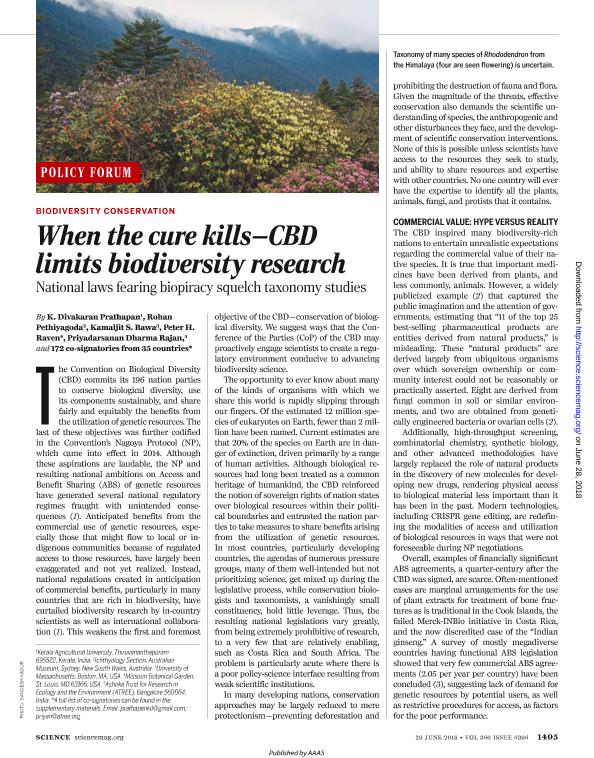Artículo
When the cure kills - CBD limits biodiversity research
Divakaran Prathapan, K.; Pethiyagoda, Rohan; Bawa, Kamaljit S.; Raven, Peter H.; Rajan, Priyadarsanan Dharma; Acosta, Luis Eduardo ; Avila, Luciano Javier
; Avila, Luciano Javier ; Baldo, Juan Diego
; Baldo, Juan Diego ; Crespo, Francisco Antonio; Pérez González, Abel
; Crespo, Francisco Antonio; Pérez González, Abel ; Ramirez, Martin Javier
; Ramirez, Martin Javier ; Sidorchuk, Ekaterina; Svavarsson, Jörundur; Twomey, Evan; Vasudevan, Karthikeyan; Vences, Miguel; de Voogd, Nicole; Wang, Qiao; Watson, Gillian W.; Weiner, Wanda M.; Wesener, Thomas; Whitmore, Daniel; Wiklund, Helena; Williams, Paul H.; Winterton, Shaun L.; Wood, Timothy S.; Yen, Shen Horn; Zaher, Hussam; Zhang, Z. Q.; Zhou, Hong Zhang
; Sidorchuk, Ekaterina; Svavarsson, Jörundur; Twomey, Evan; Vasudevan, Karthikeyan; Vences, Miguel; de Voogd, Nicole; Wang, Qiao; Watson, Gillian W.; Weiner, Wanda M.; Wesener, Thomas; Whitmore, Daniel; Wiklund, Helena; Williams, Paul H.; Winterton, Shaun L.; Wood, Timothy S.; Yen, Shen Horn; Zaher, Hussam; Zhang, Z. Q.; Zhou, Hong Zhang
 ; Avila, Luciano Javier
; Avila, Luciano Javier ; Baldo, Juan Diego
; Baldo, Juan Diego ; Crespo, Francisco Antonio; Pérez González, Abel
; Crespo, Francisco Antonio; Pérez González, Abel ; Ramirez, Martin Javier
; Ramirez, Martin Javier ; Sidorchuk, Ekaterina; Svavarsson, Jörundur; Twomey, Evan; Vasudevan, Karthikeyan; Vences, Miguel; de Voogd, Nicole; Wang, Qiao; Watson, Gillian W.; Weiner, Wanda M.; Wesener, Thomas; Whitmore, Daniel; Wiklund, Helena; Williams, Paul H.; Winterton, Shaun L.; Wood, Timothy S.; Yen, Shen Horn; Zaher, Hussam; Zhang, Z. Q.; Zhou, Hong Zhang
; Sidorchuk, Ekaterina; Svavarsson, Jörundur; Twomey, Evan; Vasudevan, Karthikeyan; Vences, Miguel; de Voogd, Nicole; Wang, Qiao; Watson, Gillian W.; Weiner, Wanda M.; Wesener, Thomas; Whitmore, Daniel; Wiklund, Helena; Williams, Paul H.; Winterton, Shaun L.; Wood, Timothy S.; Yen, Shen Horn; Zaher, Hussam; Zhang, Z. Q.; Zhou, Hong Zhang
Fecha de publicación:
06/2018
Editorial:
American Association for the Advancement of Science
Revista:
Science
ISSN:
0036-8075
e-ISSN:
0036-8075
Idioma:
Inglés
Tipo de recurso:
Artículo publicado
Clasificación temática:
Resumen
The Convention on Biological Diversity (CBD) commits its 196 nation parties to conserve biological diversity, use its components sustainably, and share fairly and equitably the benefits from the utilization of genetic resources. The last of these objectives was further codified in the Convention's Nagoya Protocol (NP), which came into effect in 2014. Although these aspirations are laudable, the NP and resulting national ambitions on Access and Benefit Sharing (ABS) of genetic resources have generated several national regulatory regimes fraught with unintended consequences (1). Anticipated benefits from the commercial use of genetic resources, especially those that might flow to local or indigenous communities because of regulated access to those resources, have largely been exaggerated and not yet realized. Instead, national regulations created in anticipation of commercial benefits, particularly in many countries that are rich in biodiversity, have curtailed biodiversity research by in-country scientists as well as international collaboration (1). This weakens the first and foremost objective of the CBD—conservation of biological diversity. We suggest ways that the Conference of the Parties (CoP) of the CBD may proactively engage scientists to create a regulatory environment conducive to advancing biodiversity science.
Palabras clave:
Nagoya Protocol
,
Pic
,
Conservation
,
Taxonomy
Archivos asociados
Licencia
Identificadores
Colecciones
Articulos(CCT - NORDESTE)
Articulos de CTRO.CIENTIFICO TECNOL.CONICET - NORDESTE
Articulos de CTRO.CIENTIFICO TECNOL.CONICET - NORDESTE
Articulos(IBS)
Articulos de INSTITUTO DE BIOLOGIA SUBTROPICAL
Articulos de INSTITUTO DE BIOLOGIA SUBTROPICAL
Articulos(IDEA)
Articulos de INSTITUTO DE DIVERSIDAD Y ECOLOGIA ANIMAL
Articulos de INSTITUTO DE DIVERSIDAD Y ECOLOGIA ANIMAL
Citación
Divakaran Prathapan, K.; Pethiyagoda, Rohan; Bawa, Kamaljit S.; Raven, Peter H.; Rajan, Priyadarsanan Dharma; et al.; When the cure kills - CBD limits biodiversity research; American Association for the Advancement of Science; Science; 360; 6396; 6-2018; 1405-1406
Compartir
Altmétricas



